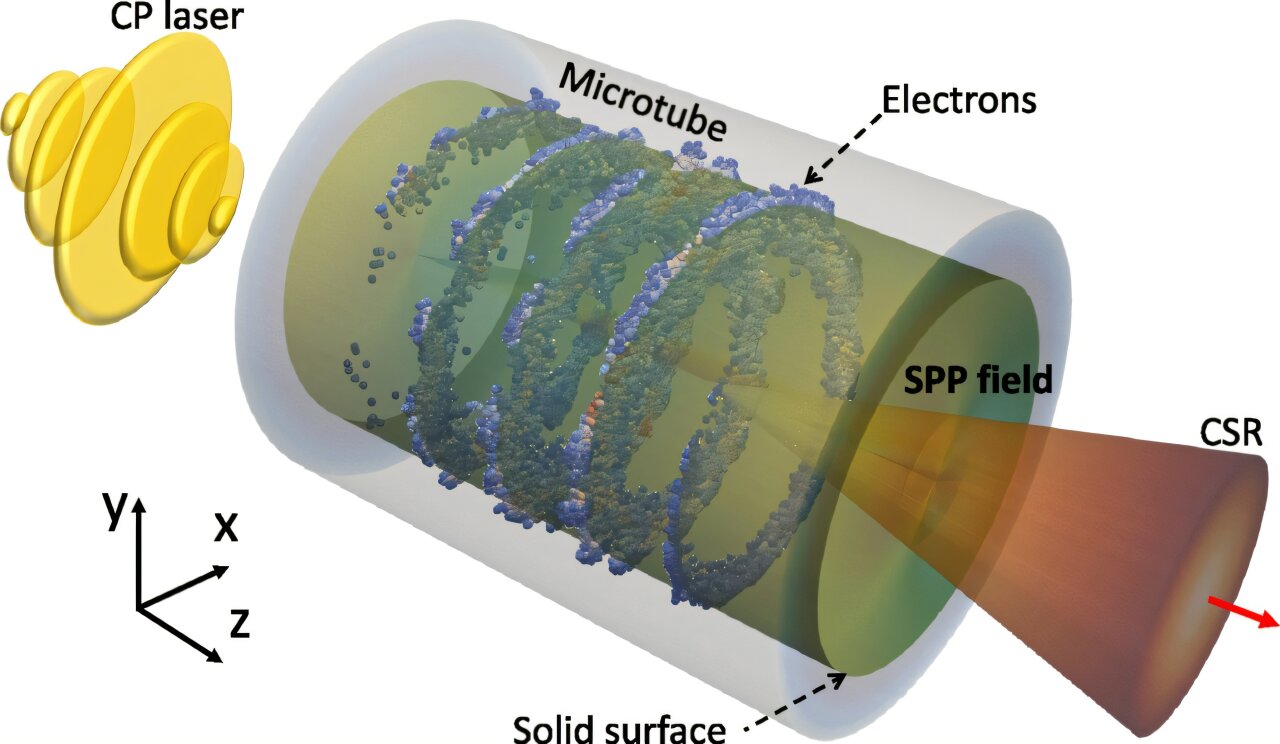
Schematic: a CP laser pulse (yellow) enters the vacuum channel of a microtube (gray) and excites SPPs while being scattered at the sharp vertical edge. The rotation mode m = ±1 (green-yellow) can efficiently couple with the laser field and accelerates the trapped electrons(sphere, blue-to-red color presents the energy) into a spiral motion along the solid surface for the CSR emission (yellow-red cone). Credit: Physical Review Letters (2025). DOI: 10.1103/cnym-16hc
A particle accelerator that produces intense X-rays could be squeezed into a device that fits on a table, my colleagues and I have found in a new research project.
The way that intense X-rays are currently produced is through a facility called a synchrotron light source. These are used to study materials, drug molecules and biological tissues. Even the smallest existing synchrotrons, however, are about the size of a football stadium.
Our research, which is published in the journal Physical Review Letters, shows how tiny structures called carbon nanotubes and laser light could generate brilliant X-rays on a microchip. Although the device is still at the concept stage, the development has the potential to transform medicine, materials science and other disciplines.
Most people imagine particle accelerators as enormous machines, very large rings of metal and magnets stretching for kilometer beneath the ground. The Large Hadron Collider at Cern (the European Organization for Nuclear Research) in Geneva, for example, is 17 miles (27km) long.
The new research shows that it may soon be possible to build ultra-compact accelerators only a few micrometers wide—smaller than the width of a human hair. These could generate coherent, high-energy X-rays similar to those produced by billion-pound synchrotron facilities, but using devices that fit on a microchip.
Twisted light
The principle relies on a particular property of light known as surface plasmon polaritons. These are waves that form when laser light clings to the surface of a material. In the simulations, a circularly polarized laser pulse was sent through a tiny hollow tube. This polarized laser pulse is light that twists as it moves, very much like a corkscrew.
The swirling field traps and accelerates electron particles inside the tube, forcing them into a spiral motion. As they move in sync, the electrons emit radiation coherently, amplifying the light’s intensity by up to two orders of magnitude.
My team and I have created a microscopic synchrotron, where the same physical principles that drive mile-scale facilities play out—but on a nanoscopic stage.
To make this concept work, carbon nanotubes were used. These are cylindrical structures made of carbon atoms arranged in hexagonal patterns. These nanotubes can withstand very high electric fields, hundreds of times stronger than those in conventional accelerators. They can also be “grown” vertically into what we call a “forest” of closely aligned hollow tubes.
This unique architecture provides an ideal environment for the corkscrewing laser light to couple with the electrons. The circularly polarized laser fits the nanotube’s internal structure—much like a key in a lock which is why we refer to a quantum lock-and-key mechanism.
The research team that I’m a part of was led by Bifeng Lei, research associate in the school of physical sciences. 3D simulations showed that this interaction can produce electric fields of several teravolts (one trillion volts) per meter. This is far beyond what current accelerator technologies can achieve.
That kind of performance could change who gets access to cutting-edge X-ray sources. At present, scientists must apply for limited time slots at large, national synchrotron facilities, or free-electron lasers, often waiting months for a few hours of beam time.
Discover the latest in science, tech, and space with over 100,000 subscribers who rely on Phys.org for daily insights.
Sign up for our free newsletter and get updates on breakthroughs,
innovations, and research that matter—daily or weekly.
Opening up access
The tabletop accelerator approach could make this capability available in hospitals, universities and industrial labs. In fact, wherever it is needed.
In medicine, this could mean clearer mammograms and new imaging techniques that reveal soft tissues in unprecedented detail, without contrast agents. In drug development, researchers could analyze protein structures in-house, dramatically speeding up the design of new therapies. And in materials, science and semiconductor engineering, it could enable non destructive, high speed testing of delicate components.
The study was presented at the 2025 NanoAc workshop on the topic of nanotechnology in accelerator physics, which was held in Liverpool earlier this month. The research currently remains at the simulation stage. But the necessary components already exist: powerful circularly polarized lasers and precisely fabricated nanotube structures are standard tools in advanced research labs.
The next step is experimental verification. If successful, this would mark the beginning of a new generation of ultra compact radiation sources. What excites me most about this technology is not just the physics, but what it represents.
Large-scale accelerators have driven enormous scientific progress, but they remain out of reach for most institutions. A miniaturized accelerator that delivers comparable performance could democratize access to world-class research tools, bringing frontier science into the hands of many more researchers.
The future of particle acceleration might include very large machines to further push the energy, intensity and discovery boundaries, as well as smaller, smarter and more accessible accelerators.
More information:
Bifeng Lei et al, Coherent Synchrotron Radiation by Excitation of Surface Plasmon Polariton on Near-Critical Solid Microtube Surface, Physical Review Letters (2025). DOI: 10.1103/cnym-16hc
Provided by
The Conversation
This article is republished from The Conversation under a Creative Commons license. Read the original article.![]()
Citation:
Tabletop particle accelerator could transform medicine and materials science (2025, November 13)
retrieved 14 November 2025
from https://phys.org/news/2025-11-tabletop-particle-medicine-materials-science.html
This document is subject to copyright. Apart from any fair dealing for the purpose of private study or research, no
part may be reproduced without the written permission. The content is provided for information purposes only.
